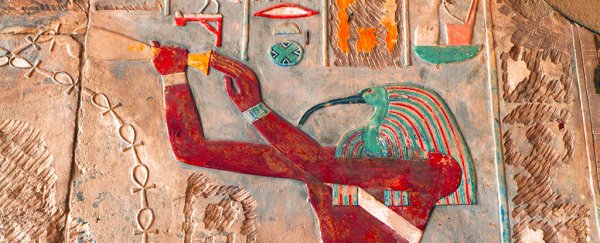Archaeologists in Egypt have made the exciting discovery of a previously unknown necropolis, untouched for millennia.
At over 2,000 years old, the cemetery dates back to the Pharaonic Late Period and the Ptolemaic dynasty, and contains at least 8 tombs, each with multiple sarcophagi.
Located south of Cairo in the Minya Governorate, the newly discovered underground tomb complex is just six kilometres (3.8 miles) from the Khmun necropolis Tuna el-Gebel.
The complex has a large number of burial shafts, and inside are a number of family graves - plenty for scientists to investigate for years to come.
"We will need at least five years to work on the necropolis," said Antiquities Minister Kaled el-Enany. "This is only the beginning of a new discovery."
Excavation began late last year, led by Mostafa Waziri, Secretary General of the Supreme Council of Antiquities. The team was searching for the uncovered section of the cemetery of the 15th nome (division) of ancient Upper Egypt.
Of particular note was one tomb belonging to a high priest of Thoth, the ibis-headed ancient Egyptian god of wisdom, arbitration, writing, science, magic and the judgement of the dead.
Identified by hieroglyphics on the canopic jars in the tomb as Djehuty-Irdy-Es, the priest was also given the title "One of the Great Five," reserved for the most senior of Thoth's priests.
Four of these canopic jars, carved from alabaster and lidded with the heads of the four sons of the god Horus, were also unearthed in the tomb, still in good condition and containing the preserved organs of the mummified priest.
In addition, the team found at least 1,000 ushabti figurines - glazed earthenware figures of servants or followers placed in Egyptian graves to accompany the deceased in the afterlife.
The mummy itself showed high rank, adorned with a bronze collar depicting the goddess Nut spreading her wings for protection in the afterlife. Blue and red beads of precious stone, bronze gilded sheets, two bronze eyes decorated with ivory and crystal, and four amulets of semi-precious stones were also found on the mummy.
There were 13 burials in the tomb. Another tomb yielded what is thought to be a family group; in all, 40 sarcophagi were unearthed from the 8 tombs found in the complex.
How much more is down there remains to be seen, but the find is already a spectacular one - last year the Ministry announced the discovery of a tomb in Tuna el-Gebel containing at least 17 mummies.
The find also seems to confirm the region's connection to Thoth. Previously, archaeologists discovered that thousands of mummified baboons and ibises - animals sacred to Thoth - had been interred there.
The Ministry hopes that the continued discoveries will help boost Egypt's tourism.
"We are very soon going to add a new archaeological attraction to Middle Egypt," el-Enany said.
